EBOOK
The Complete Guide to Customer Loyalty
Published: Jun 4, 2018
What you’ll get from this guide
Put it down to ‘shiny object syndrome’ or pressure from management, but marketers love customer acquisition – new traffic, new buyers, new social media fans, new email subscribers. Marketing strategies tend to go heavy on acquisition over retention. Perhaps there’s an assumption that existing customers will naturally return without being prompted to, but it’s by no means a given.
This assumption means marketing teams are missing a trick: it costs significantly less to retain customers than it does to acquire new ones, yet only 15% of companies are more focused on retention. Considering that the probability of selling to an existing customer is 60-70%, it makes a lot of sense to invest in retention to boost the only numbers that really matter: sales. So how can marketers engage with existing customers to increase loyalty?
In this guide you’ll find all the actionable advice and tactics you need to beef up an anaemic customer loyalty strategy, along with best practice examples from a range of industries. But first things first, what are the basics of getting started?
Customer loyalty basics
Now, we’re not saying that acquisition’s not important too: you need to grow your customer base in order to grow the business. But there’s an opportunity for marketers when it comes to loyalty – making their best customers better to drive more revenue, increase customer lifetime value and grow sustainably. According to many experts, online marketing and customer acquisition costs are rising, so loyalty is a key strategy to maintain growth.
But before implementing a customer retention strategy to improve loyalty, you first need to know what you’re working with.
Define and identify your best customers
To refocus your efforts on retention effectively, first, you need to dig deep into the data. Identify your ideal customer – someone acquired with minimal marketing spend and who makes regular repeat purchases is the holy grail, but given the flux and noise of the e-commerce market, such customers are unicorns – if you have them, you need to hang onto them with both hands.
But there are plenty of other customer segments who are also valuable. Regular seasonal buyers, big spenders, and those who have signed up to the mailing list and engaged with your content but who haven’t yet purchased are all segments that have something to offer and should be engaged accordingly.
Remember that not all customers are profitable – for example, every e-commerce retailer needs to watch out for buyers who purchase frequently but have a high rate of return who might actually be costing your business money, or fickle deal hunters, who only ever buy with a big discount.
Make sure your customer segmentation reflects the actual activity of these different types of customers and that you cater to each of them according to their potential – this can mean in email campaigns, onsite personalisation and offers.
Measure customer lifetime value (CLV)
When thinking about retention, it’s got to be a long-term strategy focusing on potential value. E-commerce marketers have an advantage over offline marketers: it’s easier to gather data on the lifecycle and spending habits of a customer. See here for a detailed look at how to calculate CLV numerically.
And don’t forget to consider engagement metrics: as marketer Damien Borichevsky says, “metrics like views and visitors can tell you whether you’re driving traffic to your content, but they’re not qualitative – they don’t tell you whether your content is actually resonating with readers who see it.”
Once you have figures to work with, you can formulate a strategy to engage those high-value customers. Remember that a retention-focused strategy is great for them too – as a customer-centric approach, they benefit from marketing that’s personalized and engaging, and ultimately they get more of what they want, which leads to increased spend.
6 tactics to boost customer loyalty
Now the part we’ve all been waiting for: best practice tactics for improving long-term customer engagement and loyalty.
1. Capture visitor details and data
Although not all visitors will become customers, capturing those who may be considering a purchase in the future, if not right now, is a significant micro-conversion that can ultimately introduce more customers into the sales funnel. Gathering this data from the outset gives customers a second chance to convert later, after being nurtured via email or through onsite personalisation.
And data doesn’t just mean contact details. This can also be linked to preferences or interests so that they can be assigned to the right segment of the mailing list from the beginning, as seen in Really Good Stuff’s email capture, which gets customers to self-select into a specific category so they can get relevant offers:
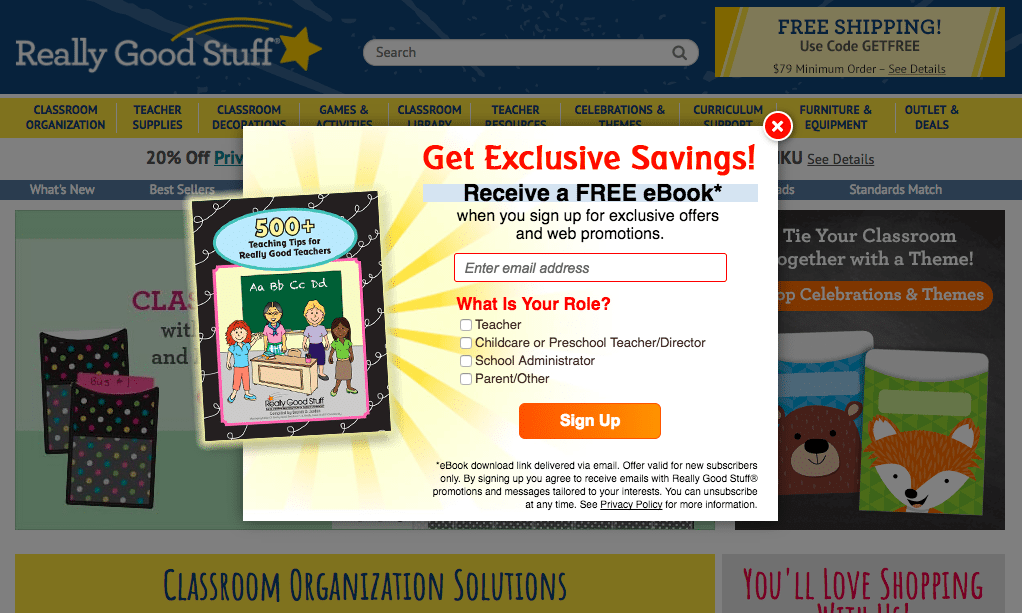
Check out our ultimate guide to email capture for the step-by-step guide to acquiring customer emails – but remember that users won’t hand over their email unless you offer something in return. And don’t forget that in a post-GDPR world you need to create opportunities to opt-in throughout the customer journey, rather than assume consent is a given.
2. Build trust
To build a long-lasting connection, trust needs to be at the foundation of the customer relationship. And after you’ve established trust, loyalty follows. As with considering the potential value of a customer over a lifetime, trust is a long game, but very rewarding – a customer who trusts your product will be more likely to share valuable information with you, such as their personal data or their thoughts and feelings, and they’re also more likely to recommend your brand to their network (and this can be leveraged through a referral scheme).
Building customers’ trust is a powerful weapon in building loyalty. For example, highlighting social proof can be an extremely effective way to build trust. Mindful Chef has coupled their email request with their Trustpilot score, highlighting the fact that it’s a trusted brand to reassure potential customers as they hand over their details, and also rewarding them with a £10 discount:
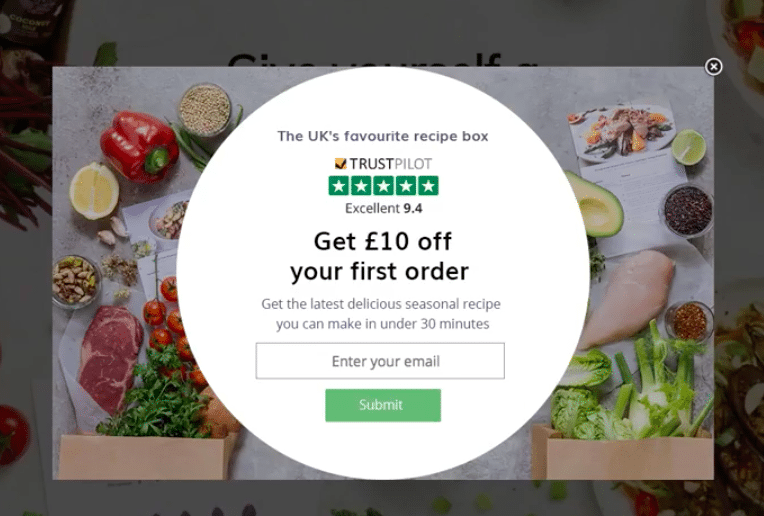
Meanwhile, Ovo Energy saw an 18% uplift in converting customers targeted with a Trustpilot overlay as they exited the checkout process:
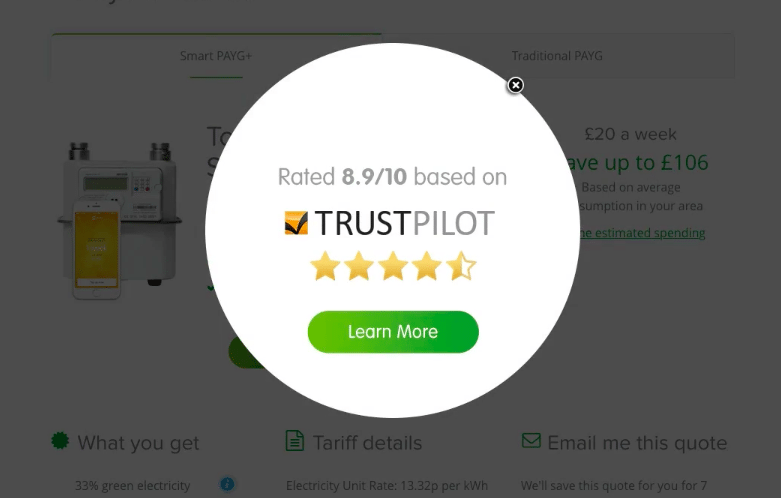
3. Personalize the journey
Marketing works best when customers feel individually spoken to, and e-commerce marketers now have a huge range of tools available to tailor customer interactions to individuals journeys and their motivations to try, buy or stay loyal change. Marketers can ‘own’ the moment where a customer chooses to purchase or exit the sales funnel by using technology to harvest and interpret data. Then, savvy marketers are creating contextualized campaigns that are triggered by proven customer behavior.
One way that brands can personalize the experience in a really simple way is by offering valuable information based on behavior. So for example, recognising intent to buy i.e. visitors who have added a product to their basket, then serving a useful notification letting them know how much they need to spend to qualify for free shipping.
Personalizing the experience is obviously easier the more information you have about a visitor, but again can be simply achieved even with new visitors. Depending on which channel a visitor arrives on your site from, think about how you can tailor the journey to meet their expectations.
Subscription box service Simply Cook uses referral source targeting to do this, recognising visitors from Facebook and then offering them a discount in exchange for their email address, providing an extra reason to convert and take-up the trial box offer. This campaign alone generated over 7,000 new leads for Simply Cook, and so they are now looking at how they can further personalize for visitors arriving from gluten-free or vegetarian content on social media.
4. Share your values
Customers increasingly want the brands they buy from to have similar values to their own. According to the Corporate Executive Board, of 7000 U.S. consumers who said they had a brand relationship, 64% cited shared values as the primary reason. In fact, shared values are “far and away the largest driver” of customer loyalty. So the message is clear: if you want loyal customers, you need to tell them what your brand stands for.
A great example of communicating brand values and highlighting reasons for consumers to stick around comes from online butcher Farmison & Co. Knowing that the audience for buying meat online is concerned about quality and provenance of produce, it highlights both its award-winning service, and the brand mission to help consumers ‘Eat better meat’. Both are highlighted throughout the website, from homepage to product pages, and emphasized using subtle corner notifications to ensure consumers are aware of the company values.
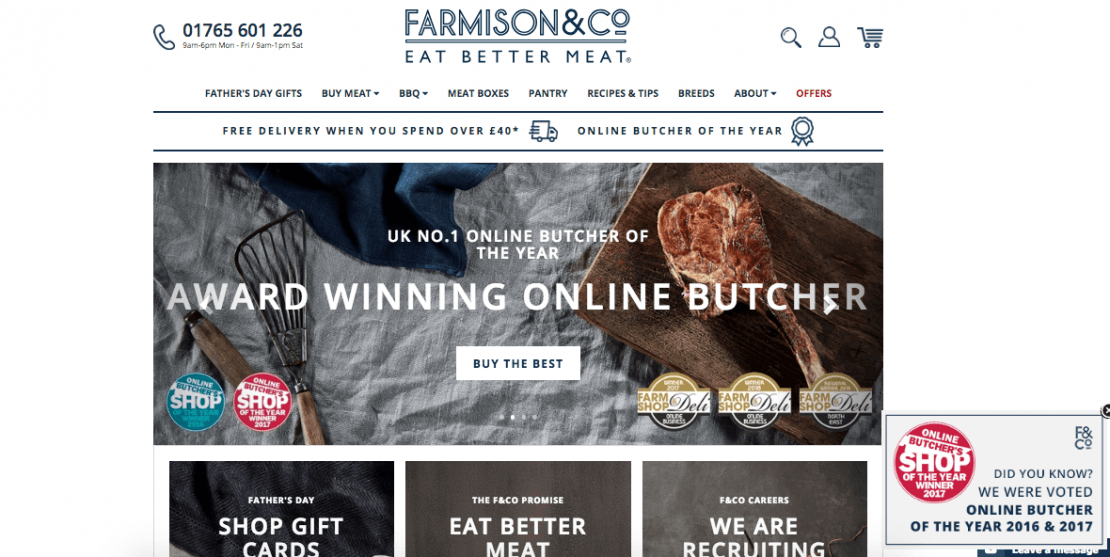
You might want to be even more specific and highlight relevant aspects of your mission and values to certain segments of customers. For example, sustainable fashion brand Reformation targets new customers, simply using copy that hints that it’s more than a brand, but a movement, and promising the customer that they’ll “connect on a deeper level”.
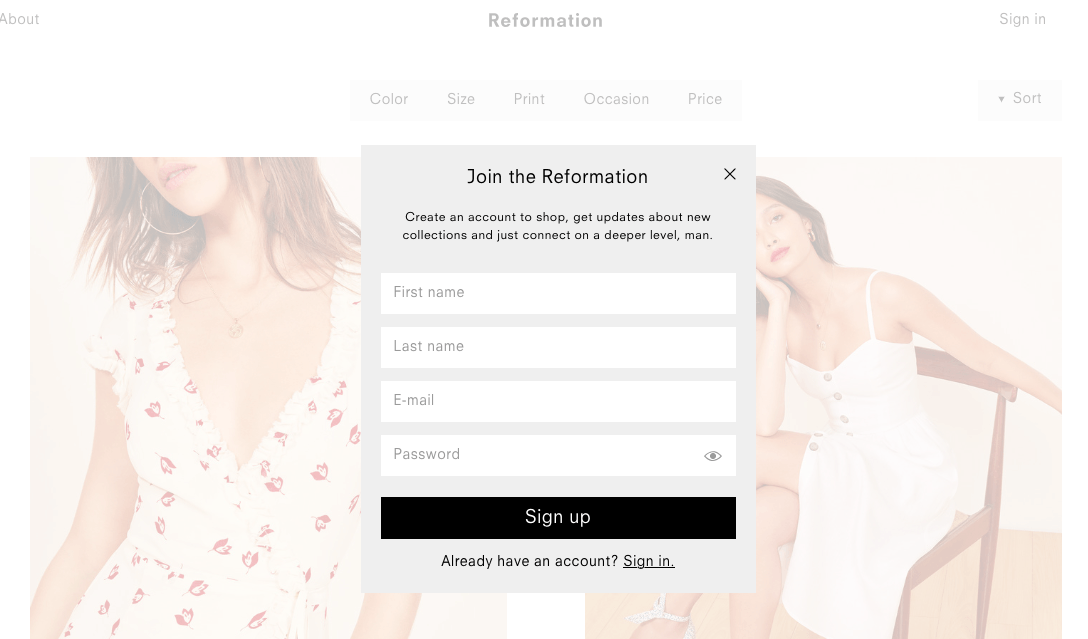
Connecting on this emotive level is a way for customers to feel a personal investment in the brand, and to associate their identity with the brand – a potent way to foster loyalty.
5. Offer post-purchase care
Nothing makes a customer feel valued and loved like a follow-up service. One of the easiest ways to keep in touch with customers is through email, so it’s essential to ask for addresses during the customer journey so you can keep customers updated on new products or ask about their experience after purchasing.
Information from satisfaction surveys can be used to improve customer satisfaction and keep your current customers happy (bearing in mind that 49% of customers have stopped shopping with a brand because of poor customer service).
See for example this personalized email following a hotel stay, signed by the general manager and requesting feedback in order to improve:
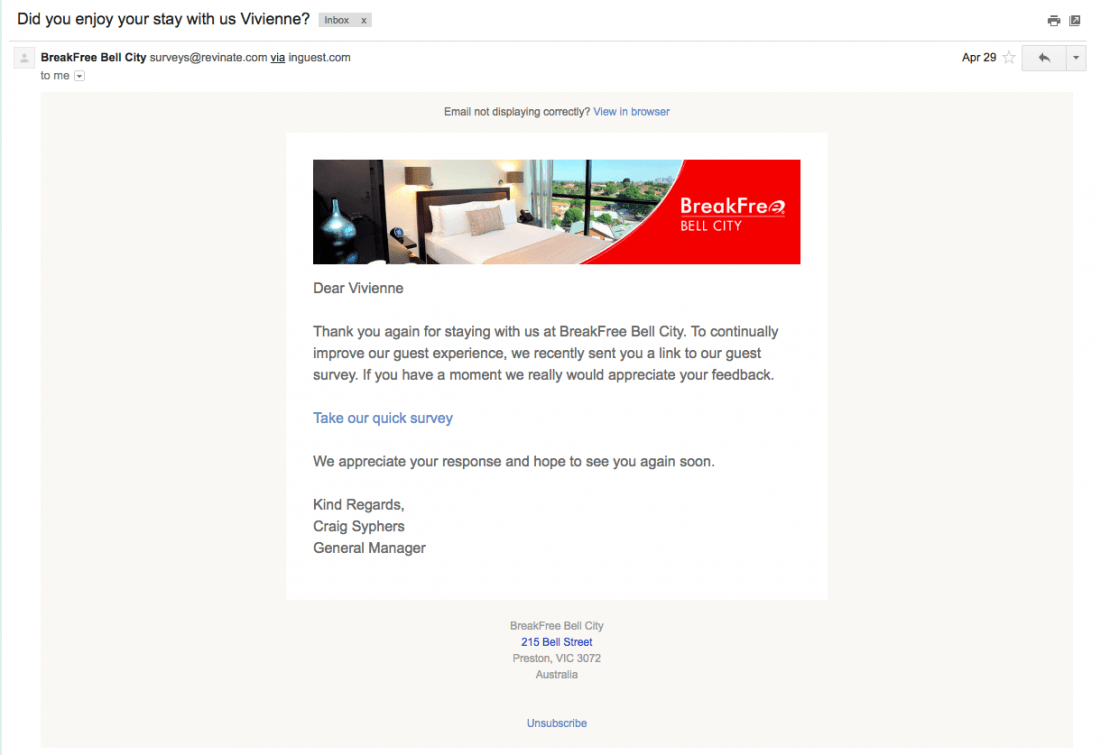
But you can’t send follow up emails if you don’t have the email address, and again it comes down to offering something of value to encourage users to register and opt-in to communications. This could be a discount, but USPs can be equally effective. The way to find out is to A/B test different messaging, to see what resonates best with your visitors and hopefully reduce the need to give away margin in exchange for emails.
Beauty brand skyn ICELAND found that while discounts had a positive impact on conversion, highlighting its natural ingredients actually performed better, driving at 28.9% increase in conversions.
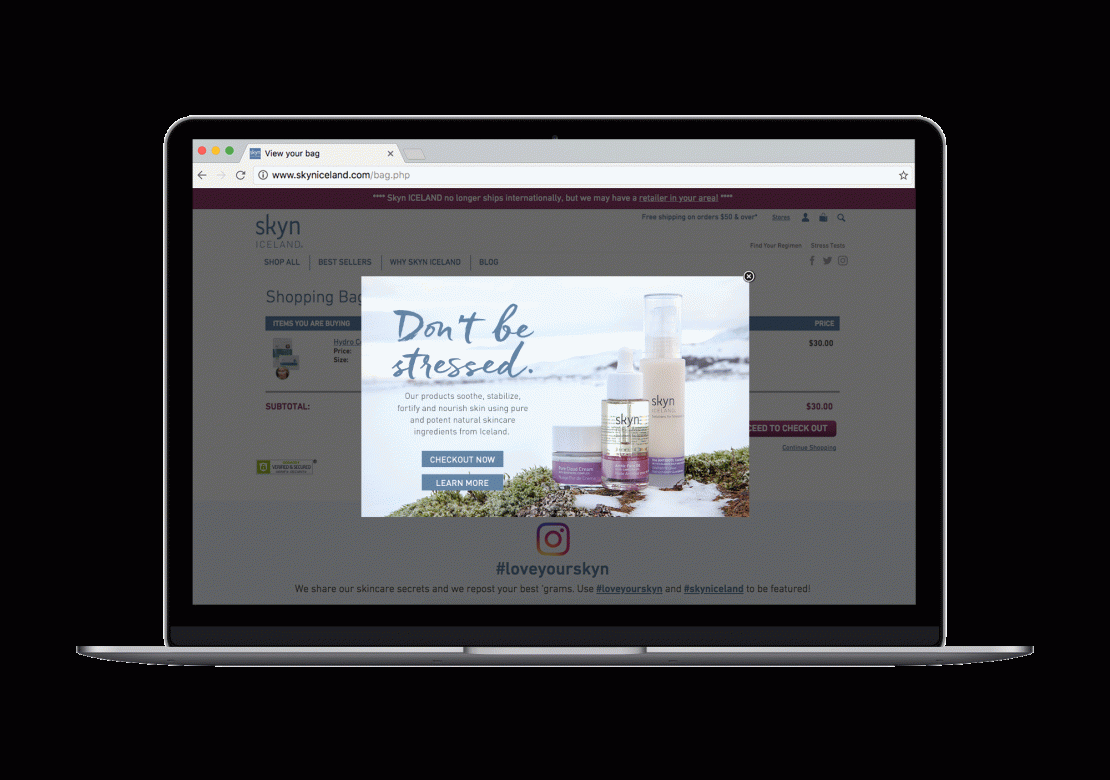
6. Implement a loyalty program
When considering customer loyalty and post-purchase advantages, you can also introduce the loyalty scheme as a mechanism for incentivising customers to come back again and again. In fact, a study of loyalty programs by Visa found that 81% of consumers said that being in a loyalty program made them more likely to continue doing business with a brand, and 66% will modify their spending to maximize rewards. Unlocking this kind of spending behavior has potential for significant ROI, and is a great way to reward those top-tier customers you identified in the planning stage with perks and offers that they really want.
Although loyalty programs can be time-consuming to design and implement, done well they are a proven way to engage customers and promote loyalty. However, even if you’ve got an excellently designed loyalty program, there is still work to do. One of the biggest challenges with loyalty programs, according to a report by Experian, is getting enough customers to sign up. Beaty brand skyn ICELAND recognized that tailoring the message to visitors would be key to driving registrations for its loyalty program. Working with Yieldify, different messages were served to new versus returning visitors, highlighting the specific benefits to each group.
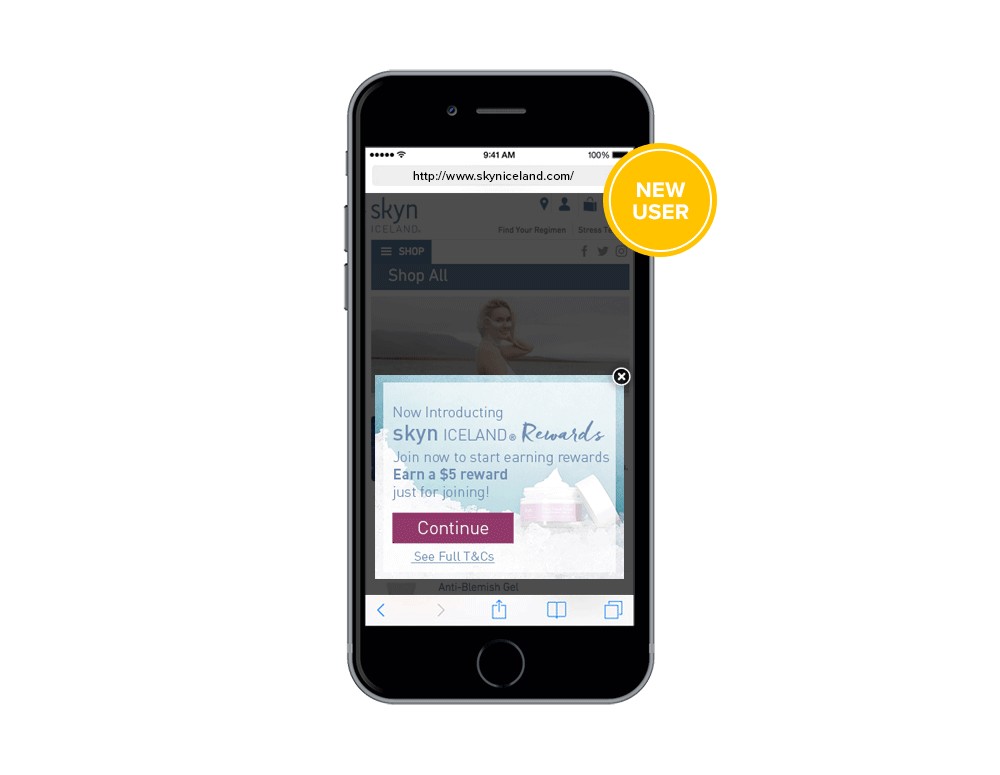
Thanks to services such as Amazon Prime, loyalty programs are evolving, with the idea of paid memberships growing in popularity. While it pays to have loyal customers, you can’t simply pay them to be loyal, so some brands have looked to flip the roles, and ask that consumers pay them for exclusive content, services and more. It’s a smart strategy given that 77% of 25-34 year olds say they’d pay to belong to a fee-based rewards program.
Retailers trialling this include Gamestop’s PowerUp Rewards, where pro members get access to exclusive discounts for $14.99 or $29.99 a month, and beauty retailers Feelunique and Sephora, who both offer a programs centred around shipping.
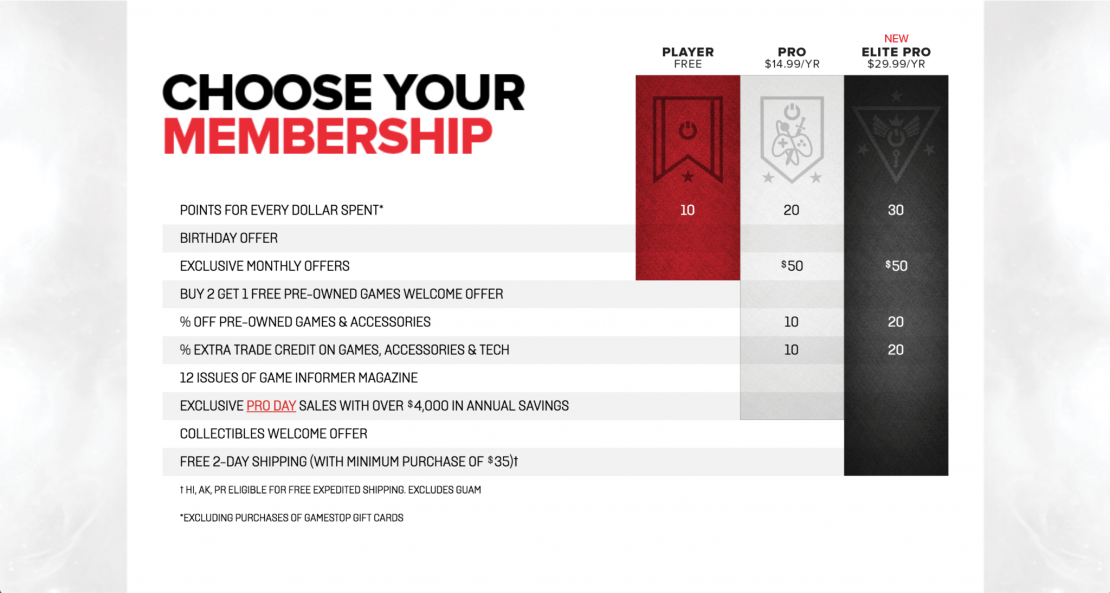
Examples from your industry
Here are some examples from different industries of laying the foundation for improved customer loyalty, further exploring some of the tactics we’ve already discussed:
Retail
In an FMCG context like retail e-commerce, marketers must be constantly engaging buyers and targeting specific segments of their traffic, activating an emotional connection to the product through content and marketing. To enhance segmentation, factors like onsite behavior or source of traffic can trigger different personalisation messages throughout the customer journey, which should be honed over time through A/B testing.
A first level to this would be to target offers specifically to returning customers, making them feel valued and incentivising them to convert. Domino’s does this with a tiered system, encouraging returning customers to increase average order value and repeat purchase, in exchange for 15% off. This drove a 16% uplift in conversion rate with returning visitors.
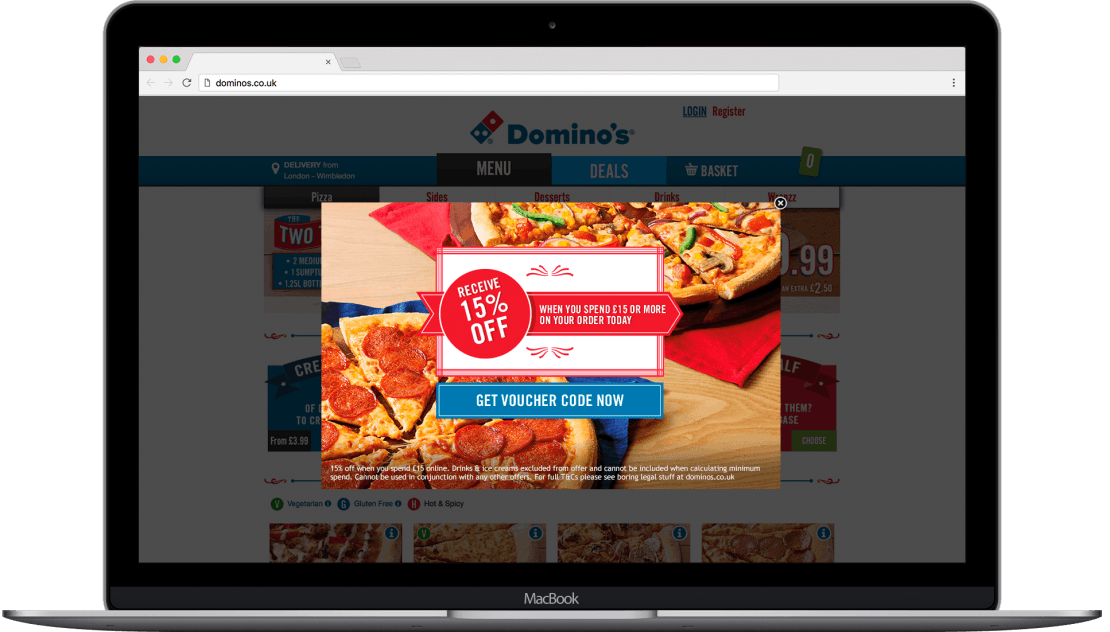
This type of tactic can be further personalized by displaying how much more the customer needs to spend based on their basket value, in order to further highlight the connection between their basket and the offer. Beauty brand Kiehl’s saw a 77.6% increase in conversion rate, along with a 32.6% increase in average order value by doing this.
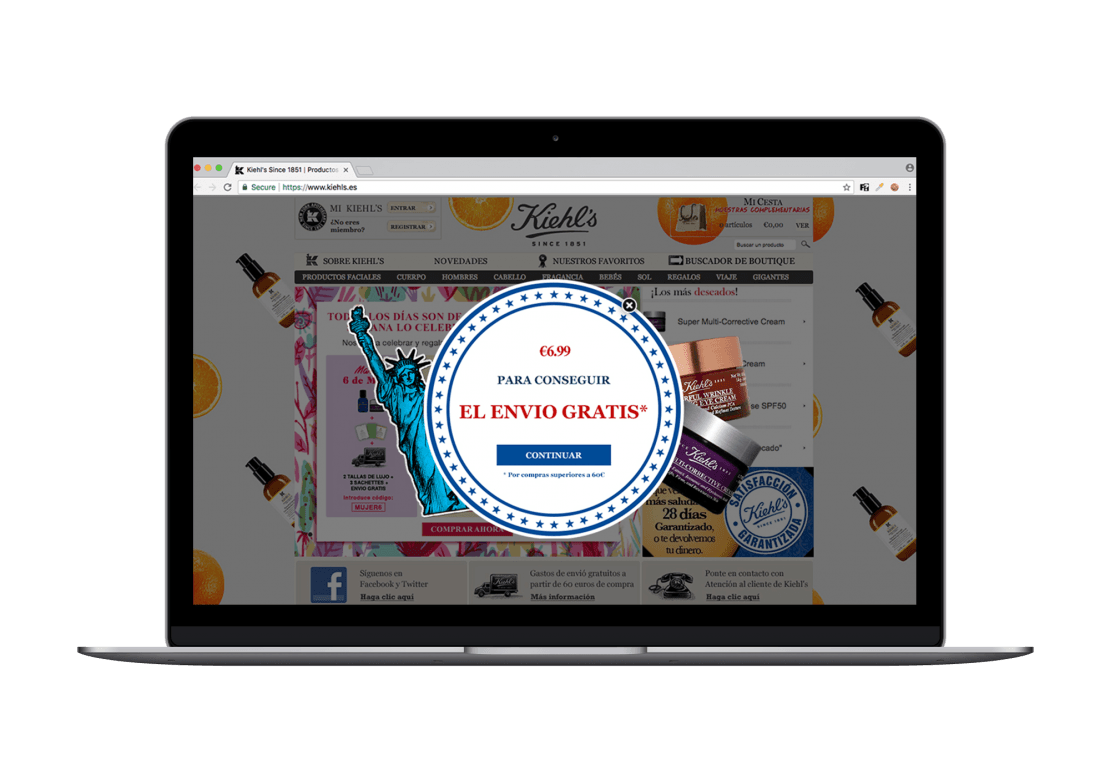
Fashion
Loyalty programs can work very well in a fashion context, and there’s a lot of cash up for grabs given that the average person spends between 15% and 23% of their discretionary income on clothing. One great example is from Urban Outfitters, whose UO Rewards scheme offers benefits for many activities – not just purchasing – and which is cleverly designed to nudge the target audience to integrate Urban Outfitters into their daily routine:
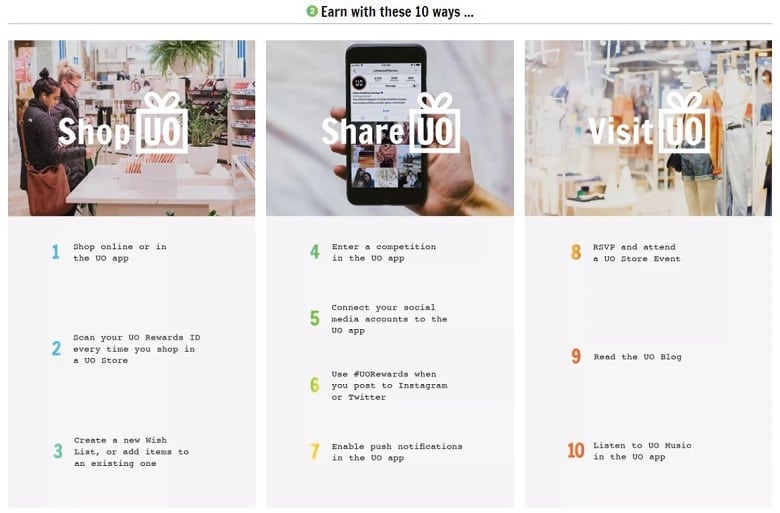
The brand has clearly thought about how they can leverage the loyalty program, and the power of psychology in e-commerce, to support marketing efforts by linking points to activities that will help grow its social media following, encourage users to create product wishlists and interact with the brands content across channels. Gamifying the experience further by introducing loyalty tiers or levels is something that Urban Outfitters could look to add, notifying users as they’re close to reaching thresholds to encourage them to convert.
Gaming
With many options in a saturated market, loyalty is a huge issue for e-gaming sites. Since gambling and betting is a similar activity across the industry, gaming companies must create a fantastic customer journey and offer competitive pricing.
Creating better user experiences through personalization can help gaming companies stand out in a crowded space. One big pain point is capturing registrations and then encouraging registrants to make their first deposit. Disruptive gaming company Bethard has encouraged visitors to complete the registration and deposit process by using a timed overlay for new users. By giving first-time visitors time sensitive offer of €10 in free credit for signing up and making a deposit, the company improved both registrations and deposits, seeing a 23% uplift in deposits.
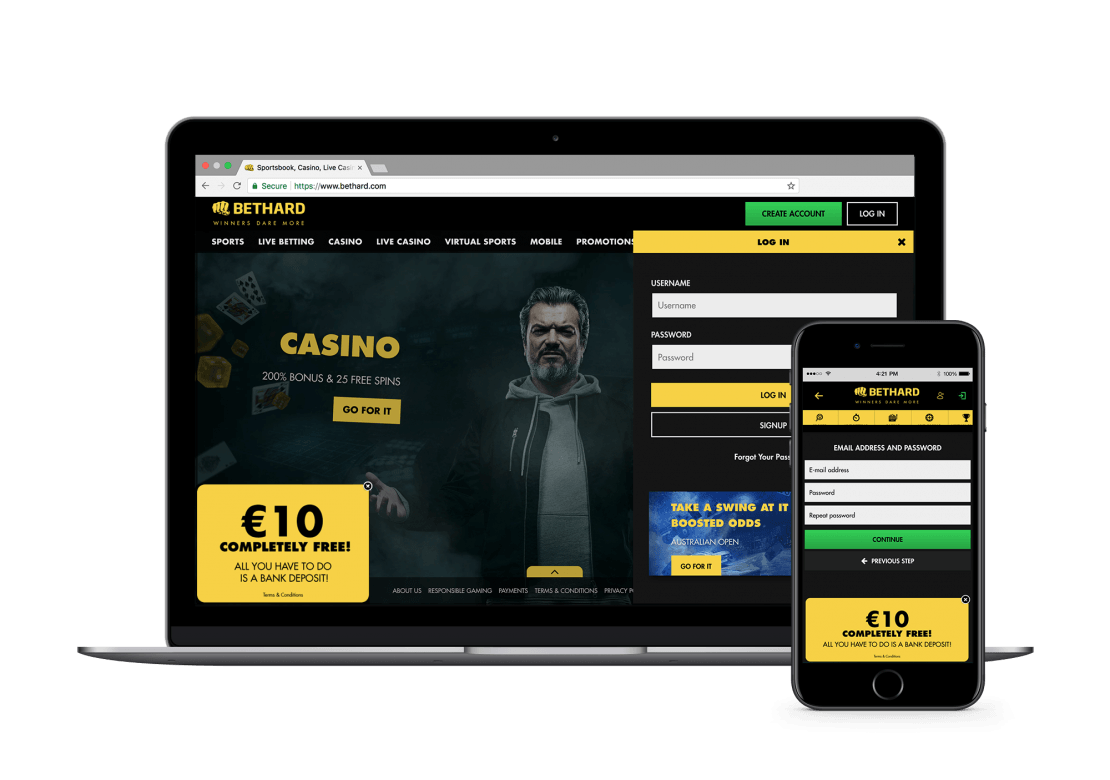
Gaming and betting companies should also consider personalization elements like device, traffic source and location when serving customers a user journey that will meet their needs, for example, promoting a specific sports fixture in their local area. These small nudges help users navigate and use the site more easily – for more on how gaming companies can optimize the user experience, see our guide to increasing gambling site performance.
Travel
The average US household is a member of 29 loyalty programs, but only active in 12. This suggests that travel customers will happily sign up to a loyalty program, but using them may be a different story. Several interesting studies have found that experiences are preferred even over flight tickets when it comes to customer loyalty rewards, and that customers are looking for to earn airline rewards from activities like car rentals and eating in restaurants. These findings imply that travel customers are looking for good deals, diversity and the opportunity to integrate loyalty systems into their everyday life, not just when travelling.
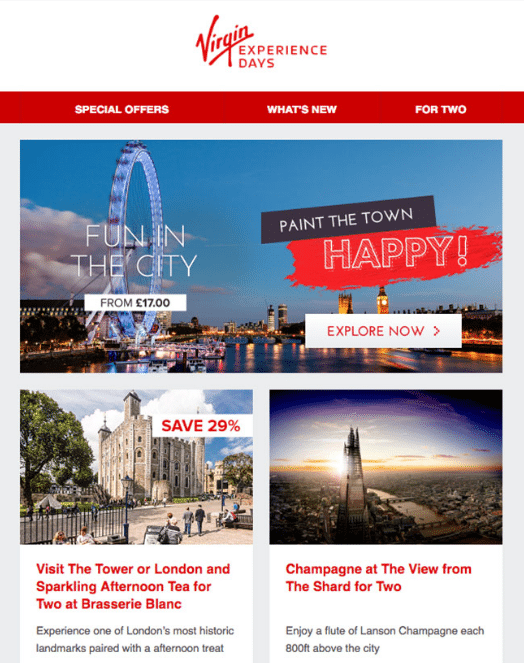
Virgin Experience Days offers loyalty members a personalized, relevant and timely experience by offering them specific experiences for their favourite locations within their email marketing – showing that gathering as much qualitative data about your power users as possible is a fantastic way to build loyalty. And the really good news? 75% of travellers are willing to share personal information in exchange for benefits.
Hilton’s Honors program significantly ups members’ user experience by allowing them to select their room, check in, and even unlock their door all from the smartphone app – an example of a loyalty program that puts customer experience right at the heart of its strategy.
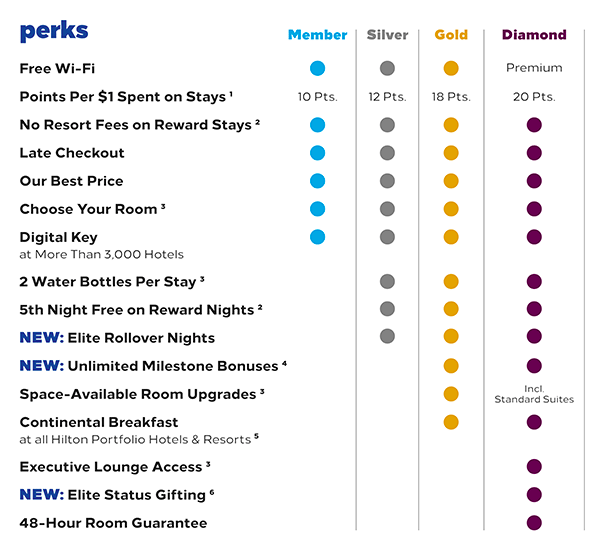
Conclusion
So what are the key takeaways for reorienting your marketing focus from acquisition to retention?
- Start by gathering data so you can identify your best customers and make them better
- Personalize the customer journey with messaging that’s triggered by specific behaviors
- Create a foundation of trust using social proof
- Share your values and USP to connect with customers’ emotions
- Follow up with a post-purchase service to show that their custom is important to the company
Acquisition is a sprint, but loyalty is a marathon. It may take time and management buy-in to establish systems like loyalty programs, but with so much potential revenue coming from your existing customers, there’s never been a better moment to get into the long-distance game.